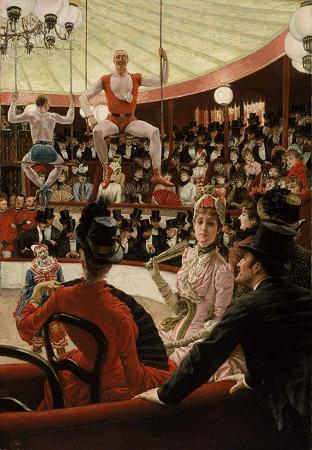Circus. A circus is a company of performers who put on diverse entertainment shows that may include clowns, acrobats, trained animals, trapeze acts, musicians, dancers, hoopers, tightrope walkers, jugglers, magicians, unicyclists, as well as other object manipulation and stunt-oriented artists. The term circus also describes the performance which has followed various formats through its 250-year modern history. Although not the inventor of the medium, Philip Astley is credited as the father of the modern circus. In 1768 Astley, a skilled equestrian, began performing exhibitions of trick horse riding in an open field called Ha'Penny Hatch on the south side of the Thames River. In 1770 he hired acrobats, tightrope walkers, jugglers and a clown to fill in the pauses between the equestrian demonstrations and thus chanced on the format which was later named a circus. Performances developed significantly over the next fifty years, with large-scale theatrical battle reenactments becoming a significant feature. The traditional format, in which a ringmaster introduces a variety of choreographed acts set to music, developed in the latter part of the 19th century and remained the dominant format until the 1970s. As styles of performance have developed since the time of Astley, so too have the types of venues where these circuses have performed. The earliest modern circuses were performed in open-air structures with limited covered seating. From the late 18th to late 19th century, custom-made circus buildings were built with various types of seating, a centre ring, and sometimes a stage. The traditional large tents commonly known as big tops were introduced in the mid-19th century as touring circuses superseded static venues. These tents eventually became the most common venue. Contemporary circuses perform in a variety of venues including tents, theatres and casinos. Many circus performances are still held in a ring, usually 13 m in diameter. This dimension was adopted by Astley in the late 18th century as the minimum diameter that enabled an acrobatic horse rider to stand upright on a cantering horse to perform their tricks. Contemporary circus has been credited with a revival of the circus tradition since the late 1970s, when a number of groups began to experiment with new circus formats and aesthetics, typically avoiding the use of animals to focus exclusively on human artistry. Circuses within the movement have tended to favor a theatrical approach, combining character-driven circus acts with original music in a broad variety of styles to convey complex themes or stories. Contemporary circus continues to develop new variations on the circus tradition while absorbing new skills, techniques and stylistic influences from other performing arts. First attested in English 14th century, the word circus derives from Latin circus, which is the romanization of the Greek, itself a metathesis of the Homeric Greek, meaning circle or ring. In the book De Spectaculis early Christian writer Tertullian claimed that the first circus games were staged by the goddess Circe in honour of her father Helios, the Sun God. The modern and commonly held idea of a circus is of a Big Top with various acts providing entertainment therein. However, the history of circuses is more complex, with historians disagreeing on its origin, as well as revisions being done about the history due to the changing nature of historical research, and the ongoing circus phenomenon. For many, circus history begins with Englishman Philip Astley, while for others its origins go back much further, to Roman times. In Ancient Rome, the circus was a building for the exhibition of horse and chariot races, equestrian shows, staged battles, gladiatorial combat and displays of trained animals. The circuses of Rome were similar to the ancient Greek hippodromes, although circuses served varying purposes and differed in design and construction, and for events that involved re-enactments of naval battles, the circus was flooded with water. The Roman circus buildings were, however, not circular but rectangular with semi circular ends. The lower seats were reserved for persons of rank; there were also various state boxes for the giver of the games and his friends. The circus was the only public spectacle at which men and women were not separated.
more...













